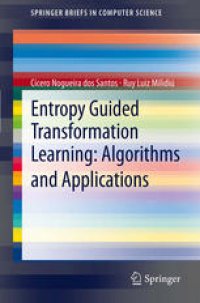
Ebook: Entropy Guided Transformation Learning: Algorithms and Applications
- Tags: Pattern Recognition, Language Translation and Linguistics, Computational Linguistics
- Series: SpringerBriefs in Computer Science
- Year: 2012
- Publisher: Springer-Verlag London
- Edition: 1
- Language: English
- pdf
Entropy Guided Transformation Learning: Algorithms and Applications (ETL) presents a machine learning algorithm for classification tasks. ETL generalizes Transformation Based Learning (TBL) by solving the TBL bottleneck: the construction of good template sets. ETL automatically generates templates using Decision Tree decomposition.
The authors describe ETL Committee, an ensemble method that uses ETL as the base learner. Experimental results show that ETL Committee improves the effectiveness of ETL classifiers. The application of ETL is presented to four Natural Language Processing (NLP) tasks: part-of-speech tagging, phrase chunking, named entity recognition and semantic role labeling. Extensive experimental results demonstrate that ETL is an effective way to learn accurate transformation rules, and shows better results than TBL with handcrafted templates for the four tasks. By avoiding the use of handcrafted templates, ETL enables the use of transformation rules to a greater range of tasks.
Suitable for both advanced undergraduate and graduate courses, Entropy Guided Transformation Learning: Algorithms and Applications provides a comprehensive introduction to ETL and its NLP applications.
Entropy Guided Transformation Learning: Algorithms and Applications (ETL) presents a machine learning algorithm for classification tasks. ETL generalizes Transformation Based Learning (TBL) by solving the TBL bottleneck: the construction of good template sets. ETL automatically generates templates using Decision Tree decomposition.
The authors describe ETL Committee, an ensemble method that uses ETL as the base learner. Experimental results show that ETL Committee improves the effectiveness of ETL classifiers. The application of ETL is presented to four Natural Language Processing (NLP) tasks: part-of-speech tagging, phrase chunking, named entity recognition and semantic role labeling. Extensive experimental results demonstrate that ETL is an effective way to learn accurate transformation rules, and shows better results than TBL with handcrafted templates for the four tasks. By avoiding the use of handcrafted templates, ETL enables the use of transformation rules to a greater range of tasks.
Suitable for both advanced undergraduate and graduate courses, Entropy Guided Transformation Learning: Algorithms and Applications provides a comprehensive introduction to ETL and its NLP applications.
Entropy Guided Transformation Learning: Algorithms and Applications (ETL) presents a machine learning algorithm for classification tasks. ETL generalizes Transformation Based Learning (TBL) by solving the TBL bottleneck: the construction of good template sets. ETL automatically generates templates using Decision Tree decomposition.
The authors describe ETL Committee, an ensemble method that uses ETL as the base learner. Experimental results show that ETL Committee improves the effectiveness of ETL classifiers. The application of ETL is presented to four Natural Language Processing (NLP) tasks: part-of-speech tagging, phrase chunking, named entity recognition and semantic role labeling. Extensive experimental results demonstrate that ETL is an effective way to learn accurate transformation rules, and shows better results than TBL with handcrafted templates for the four tasks. By avoiding the use of handcrafted templates, ETL enables the use of transformation rules to a greater range of tasks.
Suitable for both advanced undergraduate and graduate courses, Entropy Guided Transformation Learning: Algorithms and Applications provides a comprehensive introduction to ETL and its NLP applications.
Content:
Front Matter....Pages i-xiii
Front Matter....Pages 1-1
Introduction....Pages 3-8
Entropy Guided Transformation Learning....Pages 9-21
ETL Committee....Pages 23-28
Front Matter....Pages 29-29
General ETL Modeling for NLP Tasks....Pages 31-34
Part-of-Speech Tagging....Pages 35-41
Phrase Chunking....Pages 43-49
Named Entity Recognition....Pages 51-58
Semantic Role Labeling....Pages 59-69
Conclusions....Pages 71-73
Back Matter....Pages 75-78
Entropy Guided Transformation Learning: Algorithms and Applications (ETL) presents a machine learning algorithm for classification tasks. ETL generalizes Transformation Based Learning (TBL) by solving the TBL bottleneck: the construction of good template sets. ETL automatically generates templates using Decision Tree decomposition.
The authors describe ETL Committee, an ensemble method that uses ETL as the base learner. Experimental results show that ETL Committee improves the effectiveness of ETL classifiers. The application of ETL is presented to four Natural Language Processing (NLP) tasks: part-of-speech tagging, phrase chunking, named entity recognition and semantic role labeling. Extensive experimental results demonstrate that ETL is an effective way to learn accurate transformation rules, and shows better results than TBL with handcrafted templates for the four tasks. By avoiding the use of handcrafted templates, ETL enables the use of transformation rules to a greater range of tasks.
Suitable for both advanced undergraduate and graduate courses, Entropy Guided Transformation Learning: Algorithms and Applications provides a comprehensive introduction to ETL and its NLP applications.
Content:
Front Matter....Pages i-xiii
Front Matter....Pages 1-1
Introduction....Pages 3-8
Entropy Guided Transformation Learning....Pages 9-21
ETL Committee....Pages 23-28
Front Matter....Pages 29-29
General ETL Modeling for NLP Tasks....Pages 31-34
Part-of-Speech Tagging....Pages 35-41
Phrase Chunking....Pages 43-49
Named Entity Recognition....Pages 51-58
Semantic Role Labeling....Pages 59-69
Conclusions....Pages 71-73
Back Matter....Pages 75-78
....